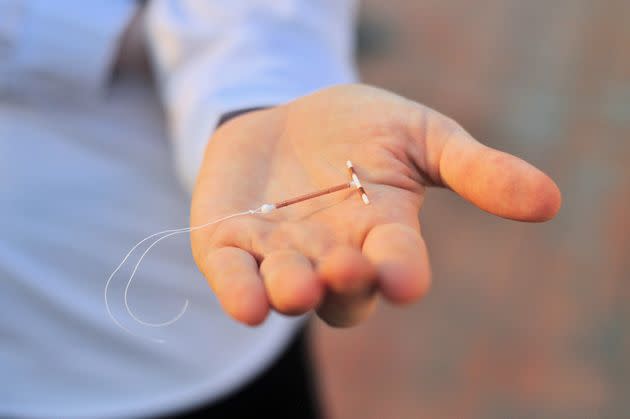Why Is The Coil Painful For Some Women And Not For Others?
Millions of women around the world use an IUD, also known as a copper coil, as contraception. If fitted properly, it can be more than 99% effective at preventing pregnancy.
But for some women, there’s a big catch: the pain. On social media, women have been sharing their experiences of insertion and removal, calling for greater awareness and better pain relief options.
It all started when Cardiff-based entrepreneur Lucy Cohen launched a petition calling for more pain relief options for women have the coil inserted. Her petition was shared by feminist campaigner and author Caroline Criado Perez, which then sparked a column by journalist Caitlin Moran, who shared her own painful experience and called for all women to be offered a local anaesthetic with treatment.
Before long, other women were publicly sharing their experiences, including BBC Breakfast presenter Naga Munchetty, who said her IUD insertion was so painful, she fainted twice and her husband could hear her screaming from the waiting room. He was so shocked, he tried to find out which room she was in so he could intervene.
It’s important to point out though, that many women have IUDs fitted with no problems at all and for these women, it can offer a great hormone-free alternative to contraceptives such as the pill.
So why do some experience such intense pain with the coil while others don’t?

Put simply, our bodies and medical histories are different, says Dr Shree Datta, consultant obstetrician and gynaecologist at The Lister Hospital.
“This depends on the individual person, the shape and size of their womb, whether they have taken pain relief or had a coil inserted previously and whether they have had children,” she tells HuffPost UK.
“It can also depend on how easy the procedure to insert the coil is and how long the procedure takes. Some women tolerate medical procedures to the womb better than others. Often (but not always!) women who have had normal deliveries of their babies find the pain much less severe – but this is compared to childbirth, of course.”
What level of pain is considered ‘normal’?
It’s common to feel some mild to moderate cramping during and after the procedure, similar to period pains, so you may like to take some pain relief beforehand.
“The pain is usually felt when the practitioner is inserting the IUD past the cervix and into the womb and most people find the pain tolerable as it is short lived due to the short length of the procedure,” says Dr Datta.
“If the pain you are experiencing is making you feel light headed, faint, nauseous or tearful during the procedure, let the doctor fitting the IUD know immediately.”
It’s also normal for some cramping to continue after your fitting for some time and you might experience some spotting or light bleeding, she adds. However, many people feel no pain at all.
“Following your fitting, if you experience continued pain or heavy bleeding, contact the doctor who inserted the IUD,” she says. “If you experience a fever in the days after the procedure, or a change in the nature or smell of your vaginal discharge, this could be a sign of an infection and you may need antibiotics.”
And if you’ve already had a coil fitted...
Try not to panic. It’s understandable if recent social media discussion has made you worried about having your IUD removed, but the removal procedure “should be less painful and quicker than having the IUD fitted,” according to the sexual health charity Brook. If you no longer want to keep your coil, it can be taken out at any time by a specially trained doctor or nurse.
A small percentage of women do experience problems with the coil and may need it removed sooner.
“During the first few months after having your IUD fitted, there is a small chance your device could move or that your body could reject the device and expel it, so it’s a good idea to learn how to self-examine for the threads that hang down from the coil,” says Dr Datta.
“These are usually felt in the vagina and your doctor will show you how to check for these at the time of coil insertion. You should check these strings regularly to ensure your coil is in the correct place. If you are unable to feel the IUD strings, this could mean that the IUD isn’t in the correct place or has been expelled, so you could fall pregnant.”
If your partner can feel the IUD during sex, you have continued severe pain that doesn’t go away after having the IUD fitted or you have persistently heavy or abnormal bleeding, it’s also worth consulting your doctor.
“Keep a record of the bleeding in a diary or app, so you get an idea of how the coil is affecting your periods,” says Dr Datta. “If you experience any unusual discharge after your fitting, or you have a fever, this could be signs of an infection and you should contact your doctor straight away. ”
This article originally appeared on HuffPost UK and has been updated.

 Yahoo Movies
Yahoo Movies 




